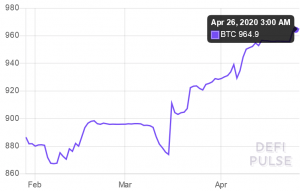Is Liquid Sidechain a Path for Better Bitcoin Privacy?
Liquid, which is more centralized than Bitcoin’s main chain, might be useful for traders seeking better privacy. Those who are interested in long term cold storage and censorship-resistant payments should use Bitcoin’s main chain.

Although Bitcoin (BTC) first hit the mainstream as a sort of anonymous Internet currency that allowed people to order drugs via darknet markets like Silk Road, the reality is transactions made on the network are completely public. Indeed, the current level of privacy offered by Bitcoin and many other cryptocurrency networks is far from ideal, although there have been a number of improvements, such as CoinJoin, implemented over the years.
While the nature of Bitcoin makes it difficult to implement changes quickly, some developers think the Liquid sidechain built on the Bitcoin network by Canada-based major blockchain company Blockstream has the potential to improve privacy for BTC users. However, others see the sidechain, which runs on a model of “federated custody,” as mostly uninteresting from a cypherpunk perspective.
Though the Lightning Network has received much more attention as an additional protocol layer for Bitcoin over the past few years, the data shows that Liquid is now leading in terms of BTC held on this sidechain.
BTC held on Liquid

__
BTC held on public Lightning Network channels

Looking for the Holy Grail of Bitcoin privacy
For a number of years, the Holy Grail for Bitcoin privacy has been theorized as a combination of two privacy features:
- Confidential Transactions (also by Blockstream), which hides the amounts involved in transactions;
- and CoinJoin (first described by Blockstream co-founder Gregory Maxwell), which makes it more difficult for a blockchain observer to connect the sender and recipient of a transaction.
Confidential Transactions is not currently available on Bitcoin’s main chain, so the most productive CoinJoin implementations force users to use equal amounts when mixing their transactions. After all, if users were mixing transactions involving varying amounts of BTC, it would be trivial for an adversary to construct a transaction graph by matching the inputs with the outputs of a particular CoinJoin transaction.
“It’s very difficult to do a CoinJoin in a way that improves privacy, and it’s also very difficult to measure how much privacy we get,” Andrew Poelstra, Director of Research at Blockstream, explained back in 2016. “By hiding amounts, we allow combining transactions in a way that we no longer have this clear correlation.”
Liquid is a federated sidechain, meaning that a group of trusted, known functionaries process transactions, rather than proof-of-work miners. It’s mostly focused on enabling faster transactions between exchanges and improving privacy for traders. The sidechain already offers a form of Confidential Transactions, known as Confidential Assets. In addition to masking the amounts involved in transactions, Confidential Assets also hides the type of asset that is being transferred. For example, when looking at the data available on the blockchain, an observer cannot tell if a user is sending L-BTC or the tether (USDT) stablecoin to another address.
However, a CoinJoin implementation is not yet available for Liquid, which means it’s still easy to see that address A sent some kind of payment to address B.
Privacy developers turned off by Liquid’s custodial model
The lack of CoinJoin availability for Liquid could have something to do with how privacy-focused developers view the federated sidechain. While developers for Samourai Wallet and Wasabi Wallet haven’t always seen eye to eye, both parties have similar feelings regarding the use of Liquid to gain better privacy.
“Samourai is bitcoin only and resolutely on-chain with a focus on on-chain privacy,” said the pseudonymous Samourai Wallet developer known as TDevD. “As BTC on Liquid is an IOU and subject to federation review on peg-out, it is not a sovereign instrument that we would be interested in handling. Samourai has always refused to develop anything less than non-custodial.”
TDevD added that this sort of reasoning is also behind Samourai Wallet’s lack of exchange integration, which would require users to turn over personal data due to various “Know Your Customer” regulations. To TDevD’s point, the introduction of any form of custody over user assets gives regulators a centralized point of failure to target with onerous regulations, licensing requirements, or complete shutdown.
Wasabi Wallet’s Adam Fiscor shared a similar lack of interest in dealing with the Liquid sidechain.
“I’m not interested in Liquid as it isn’t a replacement for Bitcoin, but rather, it is a good alternative to on-chain payments for a small subset of Bitcoin users,” said Fiscor. “[However], adding privacy to Liquid is obviously better than not.”
TDevD took their criticism of Liquid further, stating that the current privacy benefits of the sidechain are overblown.
“Confidential Transactions, as implemented within Liquid, hides amounts and asset types but not addresses,” explained TDevD. “For peg-ins and peg-outs to and from the main chain, nothing is hidden: amounts, asset types, and addresses are all visible. Even without the use of the transaction graph, anyone using Liquid as a CoinJoin tool will be subject to amount and timing analysis. Monero, with RingCT, Ring signatures, and Stealth addresses, offers better privacy and is non-custodial.”
A paper exploring this sort of amount and timing analysis problem in the Zcash privacy coin was published back in 2017 (PDF).
‘Would be pretty cool’
Meanwhile, Liquid supporters think CoinJoin on Liquid is worth trying.
“I see Liquid as another tool to use together with Bitcoin but without having its own native shitcoin token,” said Wiz, a longtime cypherpunk and early Bitcoin adopter who recently joined the Liquid federation.
“I mean I don’t know why it’s so controversial, we’re not shitcoining or scamming people like 9000 shitcoiners do every day with their pump and dump scams.”
Additionally, in terms of someone testing out CoinJoin on Liquid, Blockstream CEO Adam Back said, “I think that would be pretty cool.”
Back and Wiz both pointed out that, in terms of censorship resistance, improved privacy is extremely helpful because it makes it impossible for individual transactions to be censored, as those in charge of processing transactions cannot differentiate between different payments. The regulatory scenario then becomes all or nothing. Either regulators allow the federated sidechain to exist or they attempt to shut it down completely.
“Liquid is federated, but it’s a bit further along the spectrum from Bitcoin towards centralization,” said Back.
That said, targeting a sufficient number of Liquid functionaries to shut down the network wouldn’t be the simplest of tasks for regulators in different jurisdictions around the world.
“The exchanges that are operating Liquid nodes – the hardware security module is inside a server, which is called a functionary, so they don’t actually have any means to interfere with transactions,” added Back. “Although, to be clear, Liquid is less censorship-resistant and seizure resistant than the main chain.”
Sidechainization
According to Back, Blockstream recommends that those who are interested in long term cold storage and censorship-resistant payments should use Bitcoin’s main chain, while those who are traders or seeking better privacy may want to take advantage of the features offered by Liquid.
There have been discussions around more cypherpunks, such as Wiz, starting their own separate sidechain or creating an alternative peg-in mechanism for Liquid. However, this development might introduce new challenges, according to Back.
“One problem is seizability combined with the pseudonymity of individuals operating the network, and then another is operational security,” he said. “It could be that the cypherpunks have worse operational security compared to an exchange.”
Still, Back says Blockstream is interested in making it easier for people to run their own federations if they wish, though he cautioned that it takes a lot of work to operate and properly maintain federations.
“Think about it, if everyone made their own Bitcoin sidechains they wouldn’t be able to shut down all of them,” said Wiz. “It’s a power in numbers thing. Vires in numeris. That’s the motto of Bitcoin.”
As of now, there are plenty of opinions regarding the usefulness of something like Liquid for bringing new privacy options to Bitcoin users, but nobody can really know whether this will be a worthwhile endeavor until the relevant software exists in the wild.
__
Learn more:
BTCPay Brings Two-Way Bitcoin Privacy To Thousands of Merchants
Crypto Privacy Is a Financial Tonic to Government Intervention
Can Bitcoin Really be Censored, Controlled, and Mass Surveilled?
Here’s What Bitcoin’s 2 Biggest Privacy Wallets are Working on in 2020
Bitcoin a Step Closer to Taproot, the Biggest Upgrade Since SegWit




